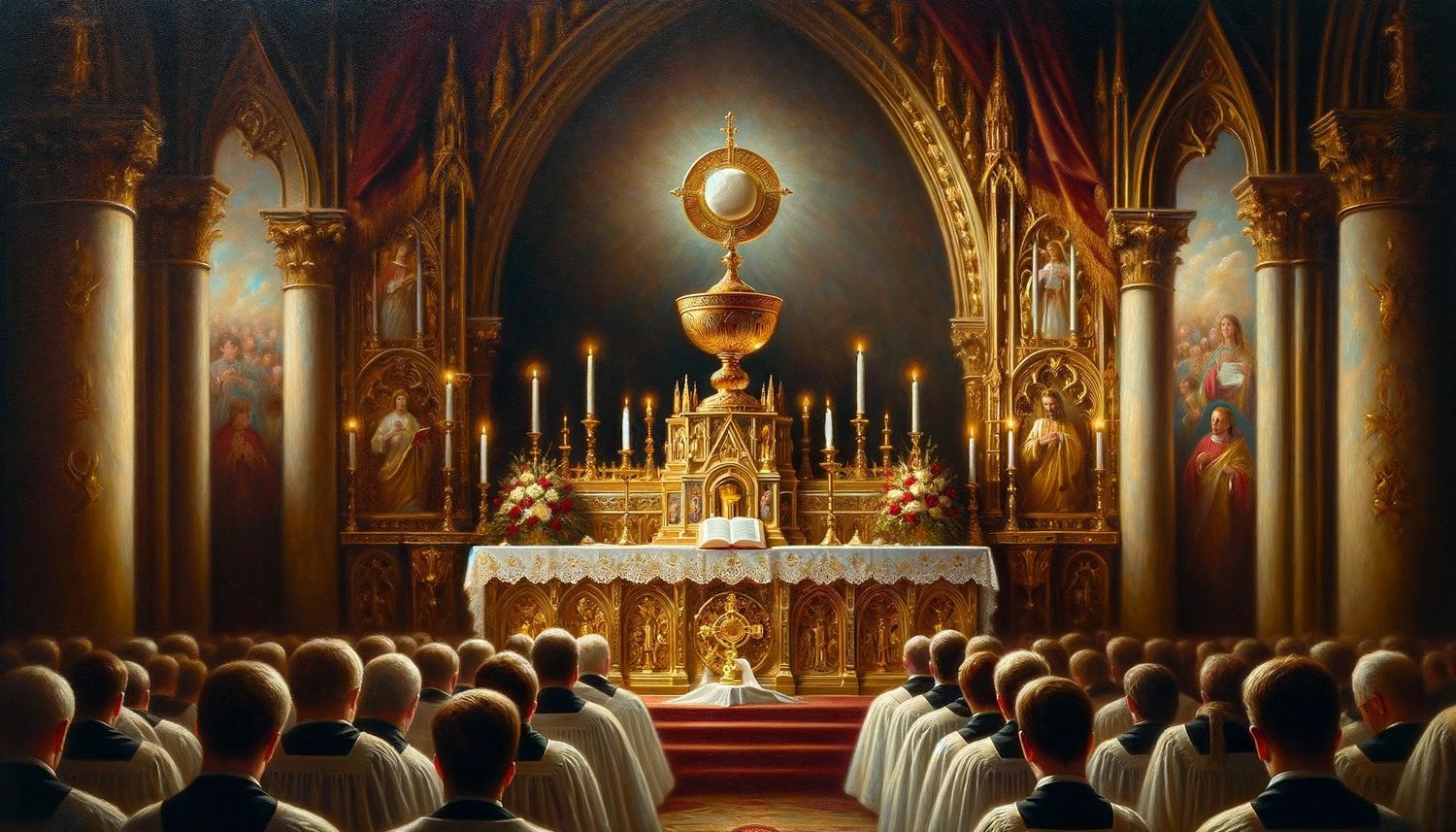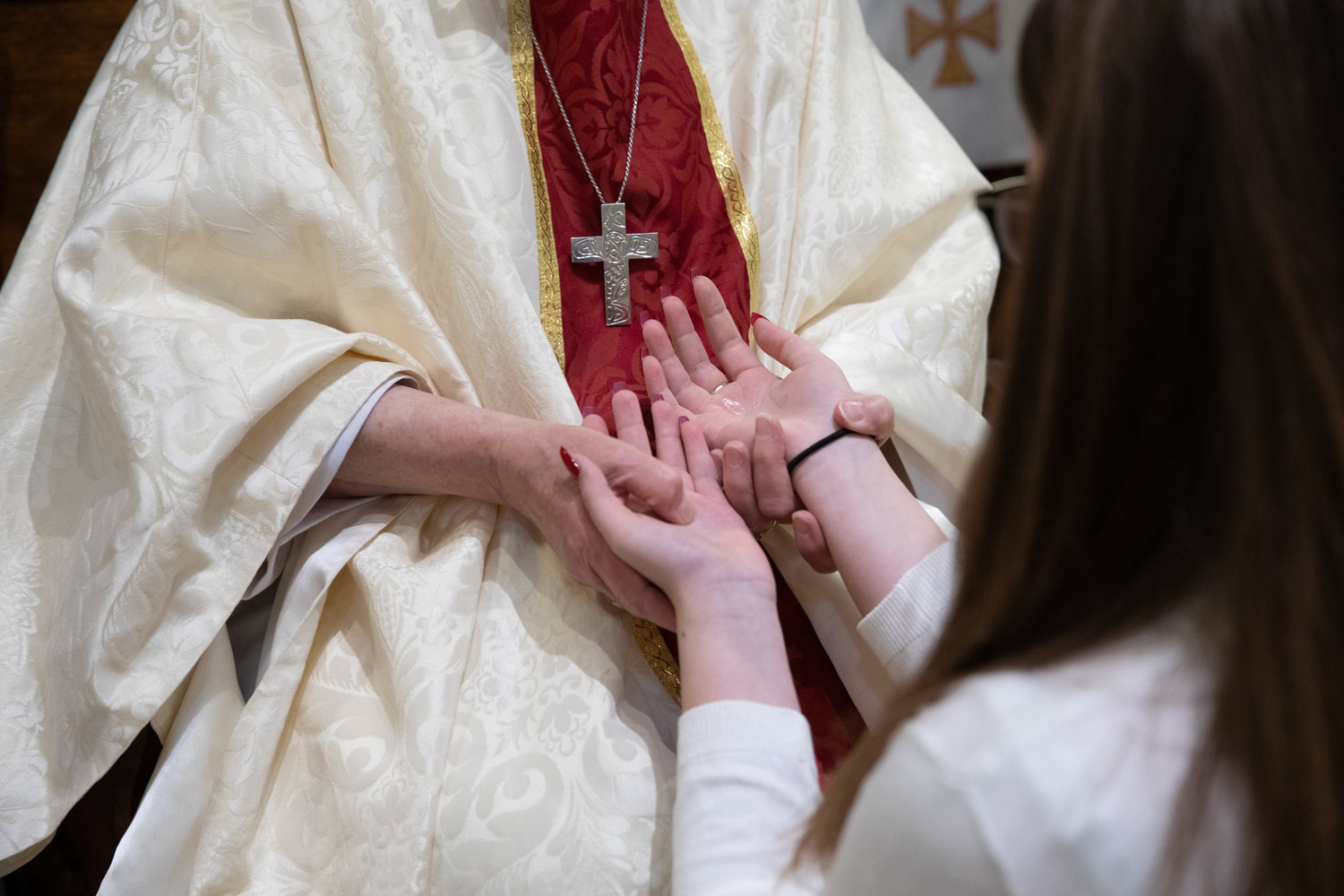Home>Theology and Spirituality>What Is The Form Of The Sacrament Of Baptism


Theology and Spirituality
What Is The Form Of The Sacrament Of Baptism
Published: February 29, 2024
Jason DeRose, Managing Editor at Christian.net, uses his expertise in religion and journalism to deepen understanding of faith's societal impacts. His editorial leadership, coupled with a strong academic background, enriches the platform’s diverse content, earning him recognition in both journalism and religious circles.
Discover the form of the sacrament of baptism and its significance in theology and spirituality. Explore the rituals and practices associated with this sacred rite.
(Many of the links in this article redirect to a specific reviewed product. Your purchase of these products through affiliate links helps to generate commission for Christian.net, at no extra cost. Learn more)
Table of Contents
The Historical Origins of Baptism
-
Ancient Rituals: The practice of baptism has ancient roots, dating back to various religious rituals and purification ceremonies in different cultures. In the Jewish tradition, ritual immersion was a common practice for purification and spiritual cleansing. This historical context provides a foundation for understanding the origins of Christian baptism.
-
John the Baptist: The New Testament accounts reveal that John the Baptist played a pivotal role in the historical origins of Christian baptism. John's baptism, as described in the Gospels, was a symbolic act of repentance and preparation for the coming of the Messiah. Many scholars view John's baptism as a precursor to the Christian sacrament of baptism.
-
Early Christian Practices: In the early Christian community, baptism was closely linked to the process of conversion and initiation into the faith. The Book of Acts and the writings of the apostles provide insights into the early Christian practices of baptism, emphasizing its significance as a rite of passage and spiritual rebirth.
-
Baptism in the Early Church: As Christianity spread throughout the Roman Empire, baptism became an integral part of the church's sacramental life. The Didache, an early Christian document, contains instructions for the baptismal liturgy, reflecting the evolving practices and beliefs surrounding this sacred ritual.
-
Symbolism and Transformation: The historical origins of baptism are intertwined with the symbolism of water as a purifying and life-giving element. The act of immersion or sprinkling with water symbolizes spiritual cleansing, death to sin, and rising to new life in Christ, reflecting the transformative nature of the sacrament.
-
Continued Evolution: Over the centuries, the form and practice of baptism have evolved within various Christian traditions, incorporating diverse liturgical elements and theological interpretations. Despite these developments, the historical origins of baptism continue to shape its significance and meaning within the Christian faith.
Read more: What Type Of Sacrament Is Baptism
The Theological Significance of Baptism
-
Cleansing and Purification: Baptism holds theological significance as a symbol of cleansing and purification. In Christian theology, the act of baptism represents the washing away of sin and the spiritual purification of the individual. This concept is deeply rooted in the belief in the transformative power of God's grace, which is symbolically manifested through the waters of baptism.
-
Union with Christ: Another theological aspect of baptism is its connection to the believer's union with Christ. The Apostle Paul's writings emphasize the idea of being "baptized into Christ," signifying a profound spiritual union with the person and redemptive work of Jesus. This theological understanding underscores the believer's identification with Christ's death, burial, and resurrection through the sacrament of baptism.
-
New Birth and Regeneration: Baptism is also significant in Christian theology as a symbol of new birth and spiritual regeneration. The concept of being "born again" or "born of water and the Spirit," as articulated in the New Testament, points to the transformative nature of baptism as a sacramental expression of spiritual rebirth. This theological perspective highlights the believer's initiation into a new life in Christ and the indwelling of the Holy Spirit.
-
Incorporation into the Body of Christ: The theological significance of baptism extends to the believer's incorporation into the body of Christ, which is the community of faith. Through baptism, individuals are not only united with Christ but also become part of the larger Christian community. This communal aspect of baptism reflects the theological understanding of the Church as the mystical body of Christ, with baptism serving as the entry point into this spiritual fellowship.
-
Seal of God's Covenant: Baptism is viewed as a visible sign and seal of God's covenant with the believer. Within the theological framework of covenant theology, baptism is regarded as a sacramental expression of God's faithfulness and the believer's response of faith and obedience. This understanding emphasizes the sacramental nature of baptism as a means of grace, affirming God's promises and the believer's commitment to a life of discipleship.
-
Participation in Christ's Death and Resurrection: The theological significance of baptism also encompasses the believer's participation in the redemptive work of Christ. The symbolic immersion in water and emergence from it parallels the death and resurrection of Jesus, signifying the believer's participation in the crucifixion of the old self and the experience of newness of life in Christ. This theological motif underscores the transformative and salvific dimensions of baptism within the Christian faith.
In summary, the theological significance of baptism encompasses themes of cleansing, union with Christ, new birth, incorporation into the body of Christ, covenantal seal, and participation in Christ's redemptive work. These theological dimensions contribute to the rich symbolism and spiritual depth of the sacrament of baptism within the Christian tradition.
The Ritual and Symbolism of Baptism
-
Water as a Symbol: Central to the ritual of baptism is the use of water, which holds profound symbolic significance across various religious and cultural contexts. In the Christian sacrament of baptism, water symbolizes purification, renewal, and the transformative power of God's grace. Whether through immersion, pouring, or sprinkling, the act of water in baptism represents a spiritual cleansing and the washing away of sin, echoing the imagery of spiritual rebirth and newness of life.
-
Immersion and Emergence: The method of immersion in water during baptism carries symbolic weight, representing the believer's identification with the death, burial, and resurrection of Jesus Christ. As the individual is submerged beneath the water, it signifies the dying to the old self and the burial of the past life characterized by sin. The emergence from the water mirrors the believer's participation in Christ's resurrection and the experience of new life in Him, symbolizing spiritual regeneration and the hope of eternal life.
-
Clothing and White Garments: In some Christian traditions, the symbolism of baptism extends to the attire worn by the baptized individual. The act of being clothed in a white garment following baptism signifies purity, righteousness, and the new identity found in Christ. This visual symbol reflects the spiritual transformation experienced through baptism, emphasizing the believer's status as a redeemed child of God and a member of the community of faith.
-
Anointing and Sealing: In certain liturgical practices, the ritual of baptism includes the anointing with oil or the laying on of hands, signifying the bestowal of the Holy Spirit and the sealing of the baptized person with the mark of God's grace. This symbolic act underscores the believer's empowerment for Christian living and service, as well as their incorporation into the larger body of Christ. The anointing serves as a visible sign of God's presence and blessing upon the newly baptized individual.
-
Community and Witness: Baptism is not merely an individual act but a communal event within the life of the Church. The presence of the faith community, including sponsors or godparents, underscores the communal nature of baptism and the responsibility of the larger Christian family to nurture and support the newly baptized in their faith journey. The participation of the congregation as witnesses to the baptismal rite reinforces the communal affirmation of the individual's entry into the body of Christ.
-
Eucharistic Connection: In some Christian traditions, the sacrament of baptism is closely linked to the celebration of the Eucharist or Holy Communion. This connection emphasizes the believer's initiation into the life of the Church and their participation in the ongoing sacramental life of the Christian community. The reception of the Eucharist following baptism signifies the individual's incorporation into the spiritual nourishment and fellowship of the Church, marking the beginning of their ongoing journey of faith and discipleship.
In summary, the ritual and symbolism of baptism encompass the use of water as a symbol of purification and renewal, the imagery of immersion and emergence, the significance of white garments, the anointing and sealing with oil, the communal nature of the sacrament, and its connection to the Eucharistic life of the Church. These elements contribute to the rich tapestry of symbolism and spiritual meaning inherent in the sacrament of baptism within the Christian tradition.
The Role of Baptism in Christian Life
-
Initiation into the Christian Faith: Baptism plays a pivotal role in initiating individuals into the Christian faith. It serves as the entry point into the community of believers and marks the beginning of a person's journey as a follower of Christ. Through baptism, individuals publicly declare their commitment to the Christian faith and become part of the larger body of Christ, embracing the beliefs, values, and practices of the Christian tradition.
-
Forgiveness of Sins and Spiritual Rebirth: In Christian theology, baptism is associated with the forgiveness of sins and spiritual rebirth. The act of baptism symbolizes the washing away of sin and the experience of new life in Christ. It represents a profound spiritual transformation, as individuals are cleansed from their past transgressions and are spiritually renewed through the grace of God. This aspect of baptism underscores its significance in the process of spiritual regeneration and the restoration of one's relationship with God.
-
Membership in the Church: Baptism is closely linked to membership in the Church. By undergoing the sacrament of baptism, individuals become full members of the Christian community, with all the rights and responsibilities that come with it. They are welcomed into the fellowship of believers and are embraced as integral parts of the Church, where they can actively participate in its worship, service, and mission.
-
Commissioning for Ministry and Service: Baptism also plays a role in commissioning individuals for ministry and service within the Church. It signifies the believer's call to live out their faith in practical ways, serving others and contributing to the mission of the Church. Through baptism, individuals are empowered by the Holy Spirit to use their gifts and talents for the edification of the body of Christ and the advancement of God's kingdom on earth.
-
Seal of God's Promises: Within the Christian tradition, baptism is regarded as a seal of God's promises and a visible sign of God's grace at work in the believer's life. It serves as a tangible expression of God's faithfulness and the believer's response of faith and obedience. The sacrament of baptism affirms God's covenantal relationship with the individual, marking the beginning of a lifelong journey of faith and discipleship.
-
Continual Spiritual Growth: Baptism is not merely a one-time event but an ongoing spiritual journey. It signifies the beginning of a lifelong process of spiritual growth, learning, and maturation in the Christian faith. Through the ongoing nurture of the Church and the guidance of the Holy Spirit, baptized individuals are encouraged to deepen their relationship with God, grow in their understanding of the Christian faith, and live out their calling as followers of Christ.
In summary, the role of baptism in Christian life encompasses initiation into the faith, forgiveness of sins, membership in the Church, commissioning for ministry, the seal of God's promises, and continual spiritual growth. Baptism holds a central place in the life of the believer, marking the beginning of a transformative journey of faith and discipleship within the Christian community.
The Form and Structure of the Baptismal Rite
-
Preparation and Welcome: The baptismal rite typically begins with a period of preparation and welcome. This may involve the presentation of the candidates for baptism, whether infants, children, or adults, to the faith community. The congregation, along with sponsors or godparents, welcomes the candidates and expresses their commitment to support them in their Christian journey. This initial phase sets the tone for the communal nature of the sacrament and the shared responsibility of nurturing the newly baptized individuals in their faith.
-
Renunciation and Affirmation of Faith: A significant aspect of the baptismal rite involves the renunciation of sin and the affirmation of faith. The candidates, or their sponsors on their behalf, renounce the spiritual forces of wickedness, reject evil, and repent of their sins. This renunciation is followed by the affirmation of faith, where the candidates, or their sponsors, profess their belief in the triune God – the Father, the Son, and the Holy Spirit. This dual declaration marks a pivotal moment of commitment and spiritual readiness for the sacrament of baptism.
-
Blessing of the Water: Central to the form and structure of the baptismal rite is the blessing of the water. The celebrant invokes the presence of the Holy Spirit upon the water, sanctifying it for the sacred purpose of baptism. This act underscores the belief in the transformative power of God's grace as symbolized through the element of water. The blessing of the water also serves as a reminder of the spiritual significance of baptism as a sacrament of initiation and rebirth.
-
Immersion, Pouring, or Sprinkling: The method of administering the water varies across different Christian traditions, reflecting diverse theological emphases and liturgical practices. Immersion, where the candidate is fully immersed in water, symbolizes the burial and resurrection with Christ. Pouring, where water is poured over the candidate's head, and sprinkling, where water is lightly sprinkled, also convey the symbolism of cleansing and spiritual renewal. The chosen mode of water administration is a significant aspect of the form and structure of the baptismal rite.
-
Anointing and Sealing: In some traditions, the baptismal rite includes the anointing with oil or the laying on of hands. This symbolic act signifies the bestowal of the Holy Spirit and the sealing of the baptized person with the mark of God's grace. The anointing serves as a visible sign of God's presence and blessing upon the newly baptized individual, emphasizing their empowerment for Christian living and service within the community of faith.
-
Welcome into the Church: Following the administration of water and any additional ritual actions, the newly baptized individuals are welcomed into the full fellowship of the Church. This may involve the clothing of the baptized with a white garment, symbolizing their new identity in Christ and their status as redeemed members of the Christian community. The congregation, along with the sponsors or godparents, reaffirms their commitment to support and nurture the newly baptized in their faith journey.
-
Eucharistic Celebration: In some Christian traditions, the baptismal rite culminates in the celebration of the Eucharist or Holy Communion. This connection underscores the believer's initiation into the ongoing sacramental life of the Church and their participation in the spiritual nourishment and fellowship of the faith community. The reception of the Eucharist following baptism signifies the individual's incorporation into the life of the Church and their ongoing journey of faith and discipleship.
In summary, the form and structure of the baptismal rite encompass the preparation and welcome of candidates, the renunciation and affirmation of faith, the blessing of water, the method of water administration, the anointing and sealing, the welcome into the Church, and the potential connection to the Eucharistic celebration. These elements collectively shape the sacramental experience of baptism within the Christian tradition, reflecting its rich symbolism and theological significance.















